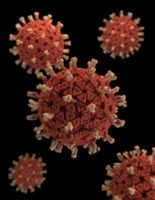20 Feb rotavirus
Posted at 13:33h
in
This illustration provides a 3D graphical representation of a number of Rotavirus virions set against a black background. Note the organism’s characteristic wheel-like appearance, which is visible when viewed under the electron microscope. It’s this morphology that gives the Rotavirus its name, which is derived from the Latin rota, meaning “wheel”. Rotaviruses are nonenveloped, double-shelled viruses, making them quite stable in the environment.
CDC- PHIL collection: Illustrator: Alissa Eckert, MS

